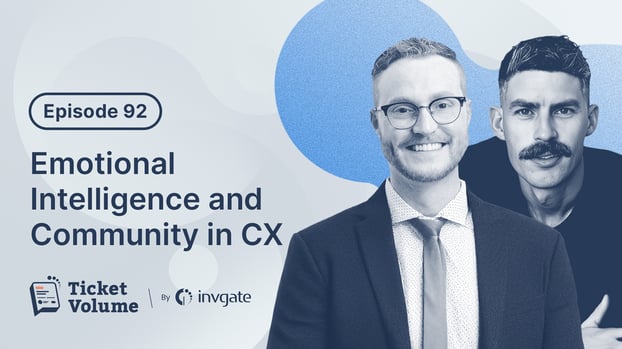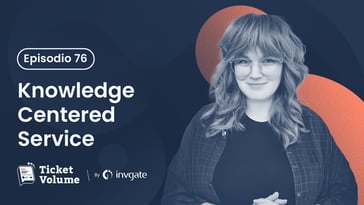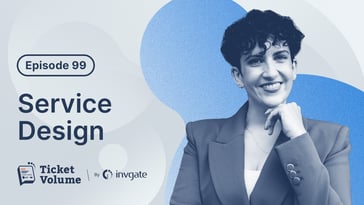What makes a truly exceptional Customer Experience and emotional intelligence strategy? Is it cutting-edge technology? Streamlined processes? Or something much deeper, like a sense of connection?
In episode 92 of the Ticket Volume - IT Podcast, host Matt Beran sat down with Michael Mattson and Luke Jamieson—two leaders in the Customer Experience (CX) space—to explore the evolving world of CX and Employee Experience (EX). They tackled everything from the importance of emotional intelligence in fostering engagement to the role of community in building stronger professional networks.
Their insights shine a light on how organizations can embrace humanity, leverage technology, and foster connections to create meaningful experiences for both employees and customers. This blog post dives into the heart of their conversation, highlighting key takeaways and practical strategies to bring these ideas to life in your workplace.
So, whether you're a CX professional, an IT leader, or just someone passionate about building better experiences, this one’s for you. Let’s explore how emotional intelligence and community-building can reshape the way we think about work, engagement, and customer satisfaction.
The evolution of CX practices: from tradition to innovation
Customer Experience is no longer just about solving problems or ensuring smooth transactions. Today, it’s about fostering deeper connections, breaking silos, and creating innovative strategies that resonate with both customers and employees. As Michael and Luke highlighted in their discussion, this evolution is driven by a need to adapt to a rapidly changing landscape and deliver experiences that feel human and personalized.
One key shift is the move from static practices to dynamic approaches like CX observability—a concept that merges real-time monitoring with actionable insights. Luke explained:
|
|
"How do you get CX observability? That’s where I’ve come across this... translating observability into CX to get a holistic picture of what’s happening for the customer and the agent in real time." Luke Jamieson |
This real-time focus empowers organizations to identify and resolve friction points faster than ever before, preventing minor issues from snowballing into significant barriers.
Michael highlighted the importance of adaptability and humanity in CX strategies, especially when using efficiency-driven tools like artificial intelligence (AI). He explained that building meaningful relationships with customers or employees often requires deviating from strict efficiency, emphasizing the need to focus on "treating people like people, not numbers."
Both guests emphasized that innovation doesn’t mean abandoning human touch; it means using technology to create space for it. By combining forward-thinking tools like AI with emotional intelligence, businesses can redefine what great CX looks like.
Emotional intelligence as the core of CX and EX
Let’s face it—emotional intelligence isn’t just a buzzword anymore. It’s a game-changer that brings humanity to workplaces and customer interactions. During the podcast, Luke reminded us that true engagement isn’t about handing out branded swag or hosting flashy events. It’s about what’s happening inside your employees—their intrinsic motivation and how they connect with your mission.
Michael chimed in with a dose of truth for leaders:
|
|
"You can’t expect stellar performance without trust. It starts with seeing your team as humans—learning what drives them, understanding their world, and leading with curiosity." Michael Mattson |
So, what’s the takeaway? Treat people like people, not cogs in the machine. When you lead with empathy and curiosity, you create a workplace where employees and customers feel valued—and that’s when the magic happens.
Employee engagement vs. Employee Experience
Here’s a question: are your employees engaged or just going through the motions? Luke broke it down perfectly—Employee Experience is about what happens to employees (like onboarding or swag bags), while engagement is about what happens within them.
The key? Don’t confuse perks with passion. True engagement comes from fostering intrinsic motivation—helping employees find meaning in their work and aligning it with their values. When you get that right, the ripple effect is incredible: happier employees, better CX, and stronger organizational loyalty.
Community building through initiatives like Twenty20ish
Building a strong community isn’t just a nice-to-have—it’s a must for growing and learning in any industry. That’s exactly what Luke and Michael set out to do with their project, Twenty20ish. The idea? Create short, engaging content to connect CX professionals, share ideas, and break out of industry echo chambers.
As Luke explained, the goal was simple:
|
|
"We wanted to give back to our community by showcasing amazing CX leaders and helping others learn from them quickly and effectively." Luke Jamieson |
The result was a fun series that not only spotlighted industry leaders but also brought people together. Whether you’re collaborating on content, attending webinars, or just chatting with peers on LinkedIn, initiatives like this prove that community is where innovation starts.
The takeaway? Don’t wait for connection to happen—create it. The stronger your network, the stronger your ideas, and the greater your impact.
The role of technology in CX
Technology has become a driving force behind modern Customer Experience and emotional intelligence, with tools like AI leading the charge. But as Michael pointed out, it’s not just about making processes faster or more efficient—it’s about creating room for meaningful human interactions.
|
|
"Sometimes the path that helps you build relationships with your customers or employees is not going to be the most efficient. Treat people like people, not numbers." Michael Mattson |
Luke also highlighted the potential of tools like observability and Journey AI to revolutionize customer journeys. By providing real-time insights, these technologies help organizations pinpoint friction points and address them proactively.
The future of CX lies in balancing technological efficiency with emotional intelligence. When tech creates space for empathy and connection, businesses can deliver experiences that feel both innovative and human.
The future of work and leadership
Workplaces are changing, and so is the role of leadership. As Luke noted, the leaders of tomorrow aren’t just taskmasters—they’re space makers, creating room for innovation, creativity, and meaningful work.
The rise of tools like AI offers a unique opportunity. By automating repetitive tasks, organizations can free up employees to focus on what really matters: solving complex problems, building relationships, and driving purpose-driven initiatives. However, this shift requires leaders who prioritize flexibility and align their teams with a clear mission.
|
|
"The future leaders are those who embrace that change by creating space for people to thrive." Luke Jamieson |
To stay ahead, organizations need to foster environments where employees feel connected to the company’s vision and values. Leadership isn’t about control—it’s about guiding teams toward shared goals and celebrating their humanity along the way.
Advice for newcomers to CX and service roles
If you’re new to the world of Customer Experience (CX) or just stepping into a service-oriented role, here’s a tip straight from Michael: get your hands dirty in a customer-facing job. Whether it’s retail, hospitality, or a call center, these roles teach you the fundamentals of building human connections.
|
|
"There’s no better way to learn about customer dynamics than being on the frontlines. It’s where you understand people, their needs, and how to adapt quickly." Michael Mattson |
Luke added that it’s also about learning from the best in the business. He recommended joining communities like the CX Accelerator on Slack or following industry leaders featured in projects like Twenty20ish.
Starting your CX journey is about more than just gaining experience—it’s about building relationships, soaking up knowledge, and staying curious. The CX world is full of eager professionals ready to share their wisdom, so don’t hesitate to reach out and connect.
Conclusion: bringing it all together
Customer and Employee Experience aren’t just about metrics or efficiency—they’re about people. As Luke and Michael highlighted, emotional intelligence, community-building, and thoughtful leadership are the keys to creating meaningful connections that drive loyalty and satisfaction.
From leveraging tools like AI to fostering intrinsic employee engagement, the future of CX and EX requires a balance of innovation and humanity. Projects like Twenty20ish remind us of the power of community, while practical advice—like starting in frontline roles—shows how anyone can begin contributing to this dynamic field.
Whether you’re a leader, an employee, or just entering the world of CX, it’s all about creating space for connection, curiosity, and growth. After all, great experiences start with a simple but powerful principle: treat people like people. You can find the full episode on Apple Podcasts, Spotify, YouTube, or your favorite podcast platform.















